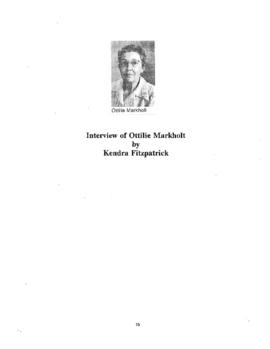Identity elements
Reference code
Name and location of repository
Level of description
File
Title
A Blue Collar Town: The Tacoma Labor Movement
Date(s)
- 1993 (Creation)
Extent
Content and structure elements
Scope and content
Oral history interview with Ottilie Markholt by Kendra Fitzpatrick conducted February-March 1993. Ottilie Markholt talks about her involvement with various Pierce County labor unions, including the Metal Trades Council and the Office Employees Union, and shares some historical perspective on the Tacoma labor movement. A noted author and historian, Markholt also describes her efforts in chronicling the histories of individual union chapters and their national affiliates and provides commentary on a series of photographs showcasing union activities during the 1920s, 1930s, and 1940s.
System of arrangement
Conditions of access and use elements
Conditions governing access
Technical access
Conditions governing reproduction
Individuals may use project materials for scholarly or research purposes, according to the provisions of fair use, but reproducing, publishing, or broadcasting any oral history project materials requires permission. No use beyond limited quotation for educational and research purposes should be made of these interviews and other materials without obtaining written permission. For more information, contact the University of Washington Tacoma Library.
Languages of the material
Scripts of the material
Language and script notes
Finding aids
Acquisition and appraisal elements
Custodial history
Immediate source of acquisition
Appraisal, destruction and scheduling information
Accruals
Existence and location of originals
This oral history is a part of the University of Washington Tacoma Community History Project. To access additional content related to this interview, see the UWT Digital Collections.


